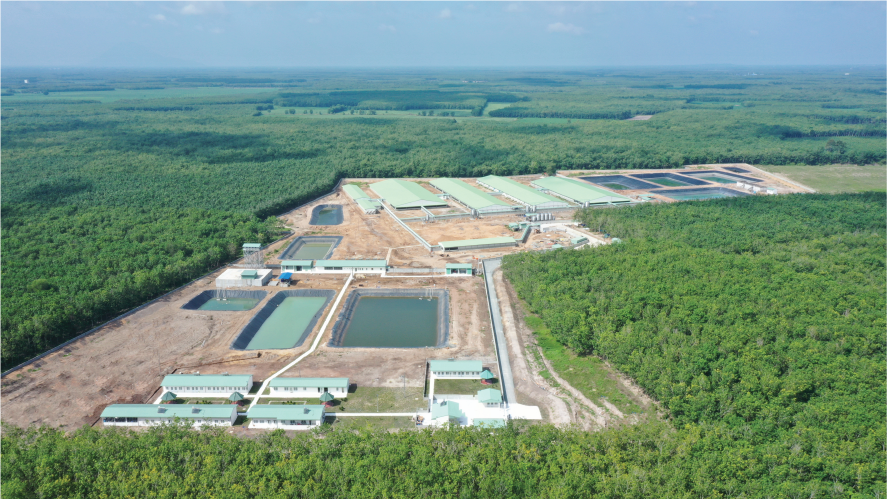(CafeF) On June 5, 2023, BAF Vietnam Agricultural Joint Stock Company (BAF, the Company) simultaneously inaugurated two modern green farms applying European technology in Tay Ninh. With the expansion, the number of operational farms has increased to 19, with a total herd size exceeding 230,000 pigs, supplying over 550,000 market pigs annually.
Nam An Khanh High-tech Sow Farm (Nam An Khanh), specializing in pig breeding, was constructed in Tan Chau District, Tay Ninh Province. With an area of 15 hectares, a capacity of 5,000 sows, producing approximately 150,000 Feeder pigs annually. The farm employs the world’s most advanced underground pit technology, ensuring a conducive environment for the animals. Modern equipment, automated management systems, and wastewater treatment imported from Europe and the United States, such as AP, Cristal, Skiold, Big Dutchman, etc.



Nam An Khanh High-tech Sow Farm
Applying strict “biosecurity belt” measures according to the world’s leading modern farming standards to achieve “biosecurity” goals. Conducting disinfection and isolation for workers for 48 to 72 hours before entering the farm to minimize the risk of disease outbreaks. The entire pig farm is divided into three functional zones: Office, production, and water supply & wastewater treatment zone. The production area includes separate pens for semen collection, sow housing, gestation pens, and farrowing pens.
The automatic feeding system, controlled by a centralized system, minimizes contact between humans and animals to reduce disease spread and labor costs. Additionally, the central cooling system maintains a stable temperature of 25-26 degrees Celsius to ensure a suitable environment for animal development.
Nam An Khanh Green Farm invests in a modern wastewater treatment system that meets Grade A standards set by the Ministry of Health and can be used for domestic purposes. It also employs advanced treatment techniques to meet the highest standards of the Ministry of Natural Resources and Environment. Pig manure is processed through three settling ponds à a water filtration plant à clean water treatment before being collected for fertilizer, contributing to environmental protection and sustainable development.
On the same day, BAF held the inauguration ceremony for Trang Trai Xanh 2 High-tech Pig Farm (Trang Trai Xanh 2) in Tan Bien District, Tay Ninh Province. Trang Trai Xanh 2 located on an area of 10.2 hectares, with a capacity of up to 30,000 pigs. Like Nam An Khanh Farm and other operational farms of BAF, Trang Trai Xanh 2 is considered a modern design, construction, and operation model applied in Vietnam.

Trang Trai Xanh 2 High-tech Pig Farm
Trang Trai Xanh 2 is invested in modern technology and equipment imported from Europe and the United States. It applies a “biosecurity belt” with three separate zones and an automated feeding system to minimize contact between humans and animals, strictly following biosecurity regulations. The advanced wastewater treatment system meets the highest standards of the Ministry of Natural Resources and Environment and the Ministry of Health, with a water circulation rate of approximately 95%.
Considering the overall factors such as the farm’s location, modern equipment and automated management imported from major European corporations, wastewater treatment processes, and high standards of water reuse set by the Ministry of Natural Resources and Environment, Nam An Khanh Farm and Trang Trai Xanh 2 can be considered the highest standard farms in Vietnam.
These are the 19th modern farms of BAF put into operation after meeting BAF and IFC’s stringent selection criteria, marking an important step in their strategy to become a leading company in the integrated modern livestock industry 3F (Feed-Farm-Food). Currently, BAF owns a system of 28 farms (19 operational and 9 under development) for breeding sows and market pigs across the country. The herd size exceeds 230,000 pigs, supplying over 550,000 market pigs annually.
The number of operational farms is expected to increase to 35-40 nationwide in the near future to expand the total herd size and proactively respond to the anticipated increase in pork prices.



